高中英语语法-形容词和副词
- 格式:ppt
- 大小:1.49 MB
- 文档页数:61

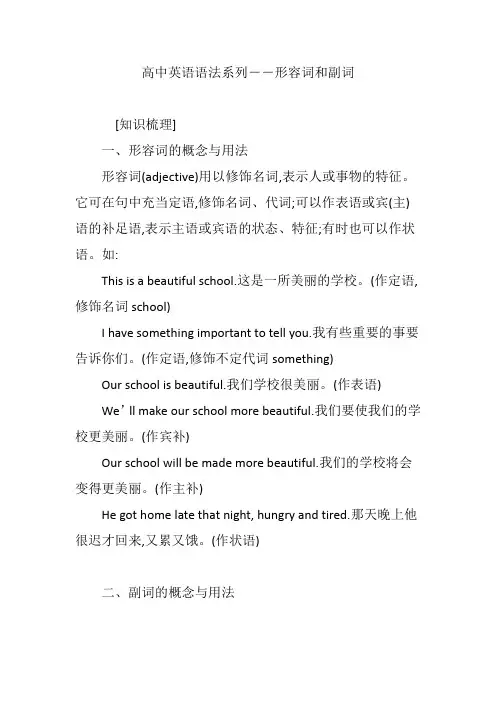
高中英语语法系列――形容词和副词[知识梳理]一、形容词的概念与用法形容词(adjective)用以修饰名词,表示人或事物的特征。
它可在句中充当定语,修饰名词、代词;可以作表语或宾(主)语的补足语,表示主语或宾语的状态、特征;有时也可以作状语。
如:This is a beautiful school.这是一所美丽的学校。
(作定语,修饰名词school)I have something important to tell you.我有些重要的事要告诉你们。
(作定语,修饰不定代词something)Our school is beautiful.我们学校很美丽。
(作表语)We’ll make our school more beautiful.我们要使我们的学校更美丽。
(作宾补)Our school will be made more beautiful.我们的学校将会变得更美丽。
(作主补)He got home late that night, hungry and tired.那天晚上他很迟才回来,又累又饿。
(作状语)二、副词的概念与用法副词(adverb)用以修饰动词、形容词或其它副词。
它在句中主要作状语,个别副词也可作表语、定语、或宾(主)语补足语。
He studies hard.他学习很努力。
(作状语,修饰动词)I’m terribly sorry for being late. 非常抱歉,我迟到了。
(作状语,修饰形容词)This coat fits him very well.这件上衣他穿着很合适。
(作状语,修饰副词)The people here are kind to us.这里的人对我们很好。
(作定语,修饰The people)When will you be back? 你什么时候回来?(作表语)三、形容词与副词的转换有的形容词加上ly后可转换成副词,规则如下:注意:friendly, motherly, lovely等词虽然以ly结尾,但不是副词,而是形容词。
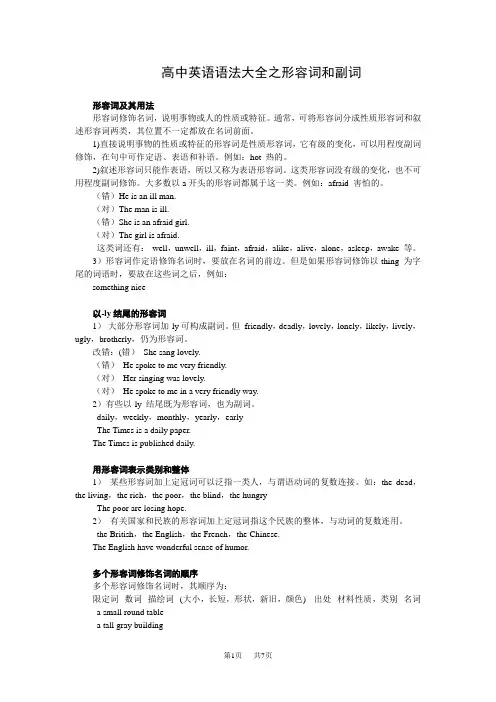
高中英语语法大全之形容词和副词形容词及其用法形容词修饰名词,说明事物或人的性质或特征。
通常,可将形容词分成性质形容词和叙述形容词两类,其位置不一定都放在名词前面。
1)直接说明事物的性质或特征的形容词是性质形容词,它有级的变化,可以用程度副词修饰,在句中可作定语、表语和补语。
例如:hot 热的。
2)叙述形容词只能作表语,所以又称为表语形容词。
这类形容词没有级的变化,也不可用程度副词修饰。
大多数以a开头的形容词都属于这一类。
例如:afraid 害怕的。
(错)He is an ill man.(对)The man is ill.(错)She is an afraid girl.(对)The girl is afraid.这类词还有:well,unwell,ill,faint,afraid,alike,alive,alone,asleep,awake 等。
3)形容词作定语修饰名词时,要放在名词的前边。
但是如果形容词修饰以-thing为字尾的词语时,要放在这些词之后,例如:something nice以-ly结尾的形容词1)大部分形容词加-ly可构成副词。
但friendly,deadly,lovely,lonely,likely,lively,ugly,brotherly,仍为形容词。
改错:(错)She sang lovely.(错)He spoke to me very friendly.(对)Her singing was lovely.(对)He spoke to me in a very friendly way.2)有些以-ly 结尾既为形容词,也为副词。
daily,weekly,monthly,yearly,earlyThe Times is a daily paper.The Times is published daily.用形容词表示类别和整体1)某些形容词加上定冠词可以泛指一类人,与谓语动词的复数连接。
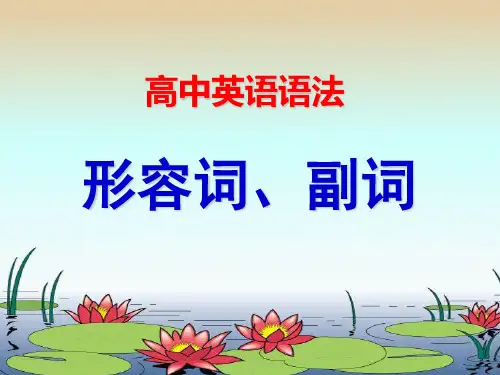
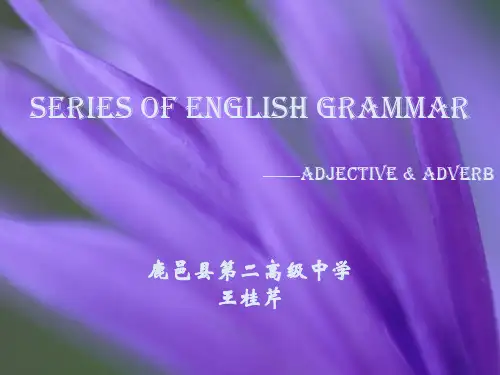

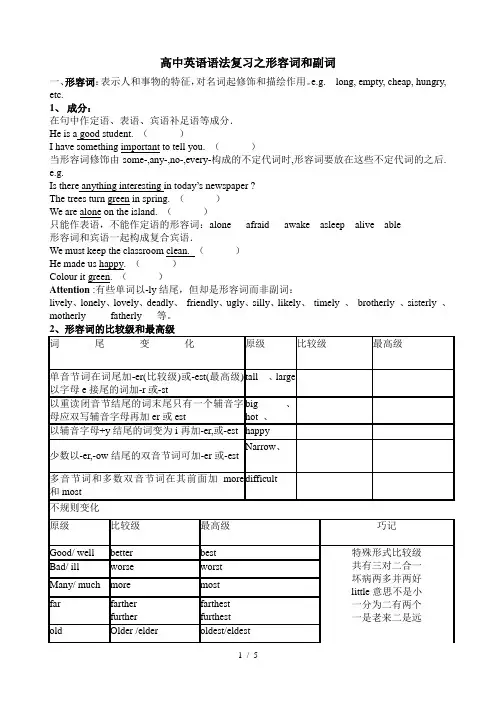
高中英语语法复习之形容词和副词一、形容词:表示人和事物的特征,对名词起修饰和描绘作用。
e.g. long, empty, cheap, hungry, etc.1、成分:在句中作定语、表语、宾语补足语等成分.He is a good student. ()I have something important to tell you. ()当形容词修饰由some-,any-,no-,every-构成的不定代词时,形容词要放在这些不定代词的之后.e.g.Is there anything interesting in today’s newspaper ?The trees turn green in spring. ()We are alone on the island. ()只能作表语,不能作定语的形容词:alone afraid awake asleep alive able形容词和宾语一起构成复合宾语.We must keep the classroom clean. ()He made us happy. ()Colour it green. ()Attention :有些单词以-ly结尾,但却是形容词而非副词:lively、lonely、lovely、deadly、friendly、ugly、silly、likely、timely 、brotherly 、sisterly 、motherly fatherly 等。
形容词的原级句型:1)as+形容词原形+asTom is as tall as Mike.Tom is three times as old as Mike.There are as many students in our school as yours.2)否定not as+形容词原形+as “和… 不一样”或not so+形容词原形+as “不及/不如…Tom is not as tall as Mike.Tom is not so tall as Mike.3)so+ 形容词原级+that丛句/such+名词+that丛句He is so big that he can’t enter the room by the door .4)… too+原级+ to do sth.He is too young to join the army.5)形容词原级+ enough to do sth.This truck is big enough to carry 5 tons.形容词比较级的句型:1)比较级+than…Our school is larger than theirs.This bridge is longer than that one.表示两者之间的选择,可使用“Which is+ 比较级,…or…?”Which is longer, this one or that?2)表示不及另一方时,使用“less+原级+than…”This park is less beautiful than that one.3)“The+比较级…,the+比较级…”The smaller the house is, the less it will cost us the heat.4)“…比较级+and+比较级…”In spring, the days are getting longer and longer.可修饰比较级的词:a bit, a little, rather, much, far, by far, many, a lot, lots, a great deal, any, still, even等典型例题:1)--- Are you feeling ____?--- Yes,I'm fine now.A. any wellB. any betterC. quite goodD. quite better2)The experiment was ____ easier than we had expected.A. moreB. much moreC. muchD. more much3)If there were no examinations, we should have ___ at school.A. the happiest timeB. a more happier timeC. much happiest timeD. a much happier time 注意:no/ not + 比较级+ than 的特殊含义• A is no more careful than B.•A和B两人都不仔细。


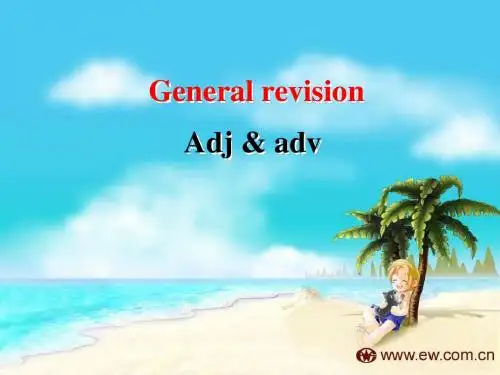
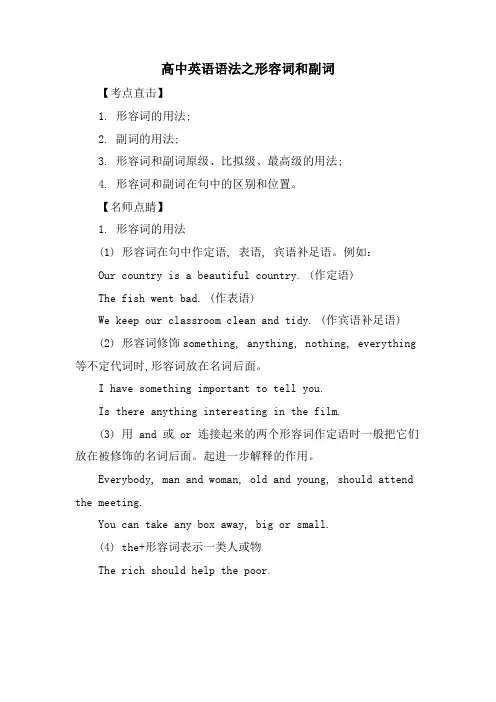
高中英语语法之形容词和副词
【考点直击】
1. 形容词的用法;
2. 副词的用法;
3. 形容词和副词原级、比拟级、最高级的用法;
4. 形容词和副词在句中的区别和位置。
【名师点睛】
1. 形容词的用法
(1) 形容词在句中作定语, 表语, 宾语补足语。
例如:
Our country is a beautiful country. (作定语)
The fish went bad. (作表语)
We keep our classroom clean and tidy. (作宾语补足语)
(2) 形容词修饰something, anything, nothing, everything 等不定代词时,形容词放在名词后面。
I have something important to tell you.
Is there anything interesting in the film.
(3) 用 and 或 or 连接起来的两个形容词作定语时一般把它们放在被修饰的名词后面。
起进一步解释的作用。
Everybody, man and woman, old and young, should attend the meeting.
You can take any box away, big or small.
(4) the+形容词表示一类人或物
The rich should help the poor.。
形容词和副词I 形容词及其基本用法形容词修饰名词,说明事物或人的性质或特征。
1.直接说明事物的性质或特征的形容词是性质形容词,它有级的变化,可以用程度副词修饰,在句中可作定语、表语和补语。
例如:hot,happy ,等。
2.叙述形容词只能作表语,所以又称为表语形容词。
这类形容词没有级的变化,也不可用程度副词修饰。
大多数以a-开头的形容词都属于这一类。
例如:afraid害怕的。
[误]She is afraid girl.[正]The girl is afraid.这类词还有: afraid,alike,alive,alone,asleep,awake 以及well,unwell,ill, faint,等。
3.形容词作定语修饰名词时,要放在名词的前边。
但是如果形容词修饰以-thing为词尾的不定代词时,要放在这些词之后。
例如:something nice.4.以1y结尾的形容词(1)大部分形容词加-1y后可构成副词。
注意:friendly,deadly,lovely,lonely,likely,lively,brotherly等是形容词。
【误】He spoke to me very friendly.[正]He spoke to me in a very friendly way.(2)有些以-1y结尾的词既为形容词,也可为副词,如daily,weekly,monthly,yearly,early等。
例如:China Daily is a daily newspaper.《中国日报》是一份日报。
China Daily is published daily.《中国日报》每天出版。
5.用形容词表示类别和整体(1)某些形容词加上定冠词可以指一类人,与复数谓语动词连用,如the dead,the living,the rich,the poor, the blind.the hungry等。
例如:The poor are losing hope.穷人将失去希望。
高考英语语法复习
形容词与副词知识讲解
一、形容词的用法
被形容词修饰的名词若还有其他词修饰,如冠词、指示代词、形容词性物主代词等,这些词要置于形容词前。
名词前的多个修饰语可用
“限定描绘大长高,
形状年龄和新老,
颜色国籍出材料,
作用类别往后靠”
来记忆。
二、易用错的几类形容词
三、形容词的比较等级
English is as interesting a subject as Chinese.
Which is the better of the two watches?
She is the taller of the two girls.
other或else把主语排除在比较对象之外;但如果不在同一范围比较则不需要用。
Susan is taller than any girl in her sister’s class.
四、副词的句法功能
五、副词的位置
六、副词比较等级的用法。
高考英语形容词与副词一、形容词01 形容词的句法功能02 形容词的位置形容词作定语时一般置于被修饰词前作前置定语,下列情况中形容词通常后置于被修饰词。
(1)修饰something,anybody,nobody,anything等复合不定代词时There is nothing wrong with the machine.(机器什么问题都没有。
)(2)形容词词组作定语时She bought a book suitable for children.(她买了本适合孩子们的图书。
)(3)修饰表示数量的词要后置The baby is only five months old.(这个婴儿仅有五个月大。
)(4)enough作形容词修饰名词时,一般放在名词之前,也可放在名词之后We don't bring enough money.(我们没带够钱。
)There‘ll be time enough to relax when you’ve finished your work.(你完成工作后会有足够的时间来放松。
)[注]形容词常见于定语位置和表语位置,以上只列出几种常见情况讲解。
具体位置要视具体形容词及句子而定。
03 多个形容词修饰名词时的语序按以下顺序排列:(1)限定词(a/an,the,this,his,first,one...)(2)表示特征或性质等描述性形容词(good,pretty...)(3)表示大小、长短、高低的形容词(big,long,little...)(4)表示形状的形容词(round,square...)(5)表示年龄、新旧的形容词(old,young,new...)(6)表示颜色的形容词(red,yellow...)(7)表示国籍、地区、出处的形容词(America,southern,Italian...)(8)表示物质材料的形容词(wooden,woollen,glass...)(9)表示用途、类别的形容词(medical,writing...)a beautiful large green Chinese carpet一块漂亮宽大的绿色的中国地毯the first three days 头三天enormous black iron gates 巨大的黑色铁门04 形容词的特殊用法二、副词01 副词的种类根据词义可分为:(1)时间副词yesterday(昨天),today(今天),now(现在)等。
高中英语语法复习专题讲解-形容词副词一、考点聚焦1、形容词、副词的作用与位置形容词是用来修饰名词的,常被放在名词前作定语,或放在系动词后面作表语。
而副词则用来修饰形容词、动词,其他副词或者句子,一般位于形容词之前,动词之后或句子之首。
以下属几种特殊情况,须牢记;(1)形容词短语作定语,定语后置。
a language difficult to master, a leaning tower about 180 feet high(2)表语形容词(afraid、alike、alone、asleep、awake、alive等)作定语,定语后置。
如a man alive。
有些表身体健康状况的形容词如well、faint、ill只作表语。
sick既可作表语又可作定语,ill如作定语意为“bad”。
(3)用作定语,修饰由不定代词one、no、any、some和every构成的复合词如anything、something等时,通常后置。
如:I have something important to tell you.(4)else常用作疑问代词和不定代词的后置定语。
(5)enough、nearby修饰名词前置或后置,程度副词一般位于形容词、副词前面,enough修饰形容词、副词时,必须后置。
(6)几个副词并列作状语时,其顺序较灵活,但一般是:方式→地点→时间。
如:We had a good time together outdoors last Sunday.(7)频度副词如often、always、usually等在be动词后,行为动词前。
(8)副词作定语,定语后置。
如:The person there is waiting for you.(9)几个并列的形容词作定语,其语序通常为:限定语(The、A)+ 描绘性形容词+ size(大小)+ shape (形状)+ age(年龄、时间)+ color(颜色)+ origin(国籍、来源)+ material(材料)+ purpose(目的)+ 名词。
高中英语语法(形容词和副词篇)位置与用法adj. 修饰n.或pron. 作定语,单个adj.放在其前(短语放在其后),修饰不定代词(不定副词)放在其后,常跟在连系V.(be, look, sound, smell,taste, feel,get, become, turn, prove...)后作表语(sounds good),也可在n./pron. 后作宾补(make him angry)或者主补(Tom was born smart.),形容词还作状语通常说明主语的情况,主要表示原因、伴随或方式,可位于句首、句中和句末,Hot and wet, you couldn’t imagine the climate her in summer.She was lying in bed, awake.形容词可与定冠词连用,相当于一个名词,泛指一类人或事物。
The beautiful is not always the same as the good.; adv.作状语,修饰v. 放在其后(eat well, run quickly,choose carefully),修饰adj.adv,放在其前(really talented),但是enough要放在所修饰词的后面(old enough)。
修饰整个句子,放在句首(Thankfully, I managed to get through the game and the pain was worth it in the end.)。
而频率副词修饰动词时要放在助动词/be/情态动词后,实意动词前。
如: He is never late for class. He never arrives late for class.地点副词、时间副词常放在句末;疑问副词(when, where, why, how)放在句首;连接副词/关系副词引导从句,放在从句前。